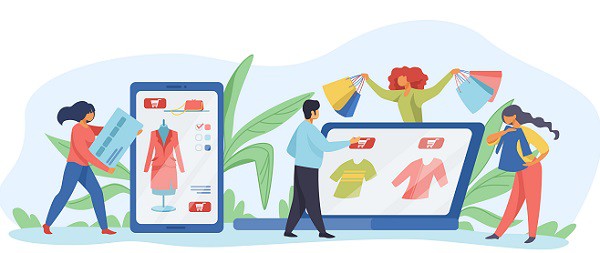Everyone and their titas are now shopping online as we continue to evolve into a thriving digital economy. If you’re thinking of starting a business or looking for ways to level up, you’ve probably heard the buzz about “direct to consumer” or DTC ecommerce.
To help you understand, we’ll dive deep into the world of DTC, explore how it shook hands with ecommerce, and discover how it’s giving the big brands a run for their money.
What is direct to consumer business model?
Direct to consumer, or DTC for short, is a business model where companies sell their products directly to customers through online channels, bypassing traditional intermediary channels like wholesalers and retailers.
This shift to DTC gained traction with the rise of ecommerce platforms and social commerce. Before, businesses had to rely on retail stores or resellers to get their products to the customers. But now, thanks to the magic of the internet, you can connect with your customers without the need for an intermediary.
This trend has democratized the playing field, giving even new micro businesses a chance to shine.
Also read: Why Filipino Sellers Embrace Social Commerce Despite Many Challenges
DTC vs Retail
DTC and retail are like comparing your friendly Facebook seller and the giant mall downtown.
In the retail model, you sell your products to a third-party, usually a retailer, who then sells them to the end consumer. On the flip side, DTC cuts out the middleman.
You, as the business owner, have a direct relationship with your customers. Similar to having a suki who orders straight from your kitchen instead of picking up the goods from a grocery shelf.

Benefits of direct to consumer ecommerce
So, why should you consider the DTC route? Here are some perks that could make your business stand out:
1. Easily compete with big brands
DTC levels the playing field against the big brands that dominate your industry.
With the power of the internet, your products can reach the same audiences as the major players. With the right strategies, you can easily turn your small business into an online sensation.
2. More control over selling channels
You decide where and how your products are presented. Whether it’s through your website, social media or a popular online marketplace. You can also control the pricing, branding and customer experience from start to finish.
3. Higher profit margins
Avoiding middlemen leads to potentially higher profits per sale. As you totally skip the wholesaler and retailer, you can set your prices more competitively without hurting your profit margins.
4. More control over customer service
DTC brands often cultivate unique identities and build closer relationships with customers. With direct communication channels, you can personally address concerns, answer queries, and build a loyal customer base.
5. Owning customer data
Direct access to customer data allows for personalization and targeted marketing. You can tailor your offerings and marketing strategies to meet their buying behavior and preferences.
6. More room to experiment based on demands or trends
DTC allows you to quickly adapt to changing trends and customer demands. Conducting market research, staying tuned to customer feedback and being open to new ideas can lead to discoveries that set your DTC business apart.
#NinjaTip: Your ecommerce business needs the right delivery partner. Get the best ecommerce shipping with dedicated account management, big rebates, No RTS fees, and fast COD remittances when you Sign up for a Ninja Van VIP Shipper account!
Challenges of direct to consumer ecommerce
As you embark on the DTC journey, be prepared to face some challenges unique to this model:
More competition online. The online marketplace is still growing, with vendors vying for attention. Standing out requires creativity, consistency, and a dash of extra effort.
You need to be good with customer service. While direct communication is an advantage, it also means you need to be on top of your customer service game. Responding promptly, addressing concerns, and maintaining a positive online presence are crucial.
Shipping and fulfillment. From managing inventory to choosing a reliable courier service, the shipping and fulfillment aspect requires careful planning and the right logistics partner.
Handling payment processing. Online transactions come with the responsibility of handling payments securely. Ensure a smooth checkout and choose trusted payment gateways.
Every business has its unique challenges, and being aware of potential roadblocks can help you navigate the DTC landscape more effectively. Stay informed, be adaptable and always be ready to tweak your strategy.
5 Tips for starting a DTC ecommerce business
Now that we’ve explored the ins and outs of DTC, here are five tips to kickstart your journey:
1. Build a strong online presence
Establish your brand across various online platforms. Create a user-friendly website, maintain active social media profiles, and engage with your audience. Remember, a strong online presence is like having a brightly lit shop in a crowded market.
2. Get creative with your product photography
Online shoppers rely heavily on visuals. All you need today are a good phone camera and online editing tools to produce images and videos. But make sure the photo quality is good and will make your products hard to resist for customers.
3. Prioritize customer experience
Customer experience is the backbone of any successful business. Ensure a seamless shopping journey, from browsing to checkout. Provide clear product information, easy navigation and responsive customer support.

4. Utilize data analytics
Leverage data to understand your customers better. Analyze purchasing patterns, preferences and demographics. This information can guide your marketing strategies and product development.
5. Stay agile and adapt
The digital landscape is ever-changing. Be updated on the latest industry trends, consumer behaviors, and technological advancements. Be ready to adapt your strategies accordingly and adjust your inventory based on the latest craze in your store.
Grow your ecommerce business with Ninja Van
Direct to consumer ecommerce has emerged as a powerful player, providing micro and small business owners with the tools to compete against big brands.
Embracing the DTC model gives you more control, connects directly with customers and unlocks a world of possibilities. But it also requires dedication, adaptability, and a keen understanding of your customers’ needs.

And when it comes to hassle-free deliveries, Ninja Van is here to give your business tailor-fit solutions so you can grow or scale up faster:
- Become a Ninja Van VIP Shipper to enjoy special rates, rebates, perks and monthly rewards
- Choose Ninja Fulfillment to streamline your inventory management and fulfillment process
- Use Ninja Direct to seamlessly source and import products from China to PH
Entrust your shipping and logistics to Ninja Van today so you can focus more on your sales and marketing efforts, and taking care of your customers.
More helpful tips for your growing business:
How 3PLs Help Your Ecommerce Business Grow
5 Psychological Marketing Tactics that Increase Sales
How to Reduce COD Parcel Rejection and Returns






